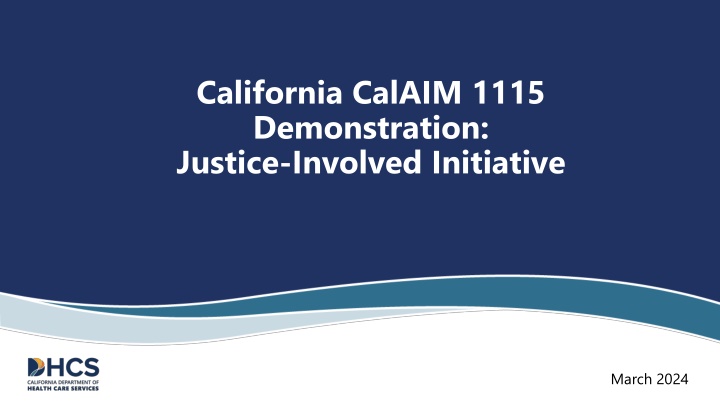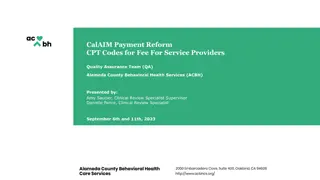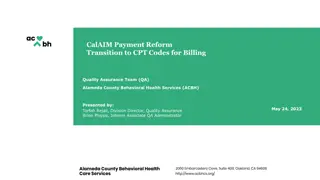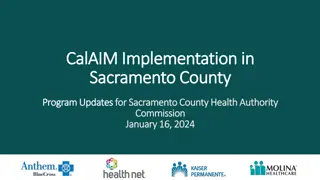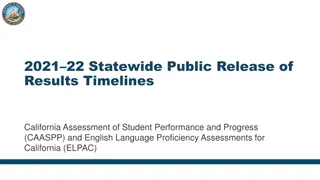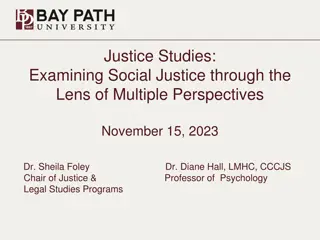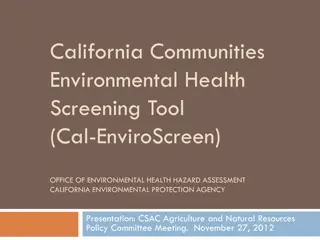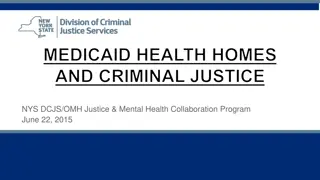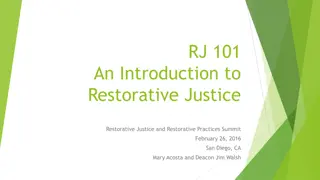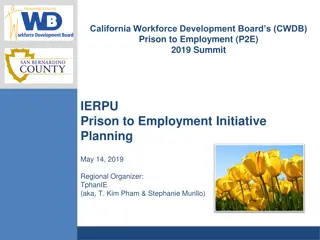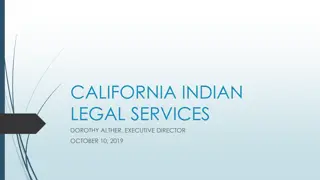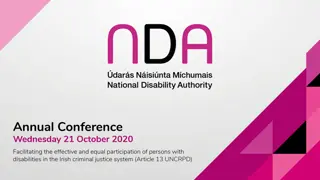California CalAIM Justice-Involved Initiative Overview
California's CalAIM Justice-Involved Initiative focuses on supporting individuals involved in the justice system by providing key services pre-release, enrolling them in Medi-Cal coverage, and connecting them with essential behavioral health and social service providers for successful reentry. The initiative includes components such as 90-day pre-release services, justice reentry and transition providers, enhanced care management, behavioral health links, community supports, and pre-release Medi-Cal application processes.
Download Presentation

Please find below an Image/Link to download the presentation.
The content on the website is provided AS IS for your information and personal use only. It may not be sold, licensed, or shared on other websites without obtaining consent from the author.If you encounter any issues during the download, it is possible that the publisher has removed the file from their server.
You are allowed to download the files provided on this website for personal or commercial use, subject to the condition that they are used lawfully. All files are the property of their respective owners.
The content on the website is provided AS IS for your information and personal use only. It may not be sold, licensed, or shared on other websites without obtaining consent from the author.
E N D
Presentation Transcript
California CalAIM 1115 Demonstration: Justice-Involved Initiative March 2024
California Actively Works With Implementation Partners Over the past 24 months, DHCS has actively met with its Justice-Involved Advisory Group and one-on-one with implementation partners, to inform the 1115 Demonstration and provide input into development of operational policies. Justice-Involved Advisory Group members include: CDCR/California Correctional Health Care Services (CCHCS) which delivers health care services in State prisons County Jails, including correctional officers and correctional health staff Chief Probation Officers of California (CPOC)/County Youth Correctional Facilities Board of State and Community Corrections (BSCC) County Welfare Directors Association (CWDA) County Social Service Departments (SSDs) County Behavioral Health Department (including working group of county behavioral health directors) Council on Criminal Justice and Behavioral Health (CCJBH) Office of Youth and Community Restoration (OYCR) Reentry Providers (including TCN, STOP, Healthright360, WestCare, and Amity Foundation) Medicaid managed care plans Individuals with lived experience Community based organizations Listen to this Medicaid Leadership Exchange podcast episode to hear more about the importance of collaboration with implementing partners 1
The CalAIM Justice-Involved Initiative is Comprised of Pre- Release and Reentry Components CalAIM justice-involved initiative support justice-involved individuals by providing key services pre-release, enrolling them in Medi-Cal coverage, and connecting them with behavioral health, social services, and other providers that can support their reentry. Initiatives Include: 90 Days Services Pre-Release (1115 Waiver) Justice Reentry and Transition Providers Enhanced Care Management Behavioral Health Links Community Supports Pre-Release Medi-Cal Application Processes Reentry 2
Eligible Correctional Facilities State law (WIC 14184.102) requires the following correctional facilities to provide Medi-Cal services in the 90-days prior to release: State Prisons County Jails, Detention Centers, Detention Facilities County Youth Correctional Facilities Pre-release services will only be provided to individuals prior to leaving a correctional facility and reentering the community. 90-Day Pre-Release Services do not include: State forensic mental health hospitals (i.e. Department of State Hospital facilities) City Jails Federal Prisons 3
State Mandate for Pre-Release Services and Behavioral Health Links Pre-Release Services Welfare & Institutions Code section 14184.102 required DHCS to seek federal approval for and to implement the CalAIM initiative, which includes the provision of targeted pre-release Medi-Cal benefits to qualified individuals. Provides DHCS with authority to implement pre-release services by means of all-county letters, plan letters, provider bulletins, information notices, or similar instructions, without taking any further regulatory action. With the 1115 demonstration approved by CMS, the CalAIM Special Terms and Conditions (STCs) related to the Justice-Involved Reentry Initiative are mandatory per federal and state law. Behavioral Health Links CA Penal Code 4011.11 (2021) requires DHCS to develop and implement a mandatory process by which county jails and county juvenile facilities coordinate with Medi-Cal managed care plans and Medi-Cal behavioral health delivery systems to facilitate continued behavioral health treatment in the community for county jail inmates and juvenile inmates that were receiving behavioral health services before their release. 4
Justice-Involved Initiative Timeline Pre-Release Medi-Cal Application Mandate: requires all counties to facilitate enrollment in Medi-Cal for individuals who are incarcerated January 1, 2023 January 1, 2023 Enhanced Care Management for the Population of Focus for Adults and Youth who are transitioning from incarceration January 1, 2024 January 1, 2024 2-Year Period for Correctional Facilities to Go Live with 90-Day Pre-Release Services Correctional Facilities will have a six-month readiness assessment review and approval process prior to the go-live date. October 1, 2024 October 1, 2024- - September 30, 2026 September 30, 2026
Policy and Operational Guide On October 20, 2023, DHCS released the updated Policy and Operational Guide for Planning and Implementing the CalAIM Justice Involved Initiative. This guidance lays out to implementing stakeholders correctional facilities, County Behavioral Health Agencies, providers, community-based organizations, and Medi-Cal managed care plans, among others the policy, design and operational processes that will serve as the foundation for implementing this important initiative. DHCS will update the Policy and Operational Guide on an as needed basis as implementing partners begin to advance the process of standing up the JI Initiative and as CMS continues to refine its sub-regulatory guidance for states that receive 1115 demonstration approval. 6
Eligibility Criteria for Pre-Release Services Medi-Cal-eligible individuals who meet the pre-release access screening criteria may receive targeted Medi-Cal pre-release services in the 90-day period prior to release from correctional facilities. DHCS developed detailed definitions for qualifying criteria, based on extensive stakeholder feedback (See Appendix). Criteria for Pre-Release Medi-Cal Services Incarcerated individuals must meet the following criteria to receive in-reach services: Be part of a Medicaid or CHIP Eligibility Group, and Meet one of the following health care need criteria: Mental Illness Substance Use Disorder (SUD) Chronic Condition/Significant Clinical Condition Intellectual or Developmental Disability (I/DD) Traumatic Brain Injury HIV/AIDS Pregnant or Postpartum Note: All Medi-Cal/CHIP eligible youth incarcerated at a youth correctional facility are eligible to receive pre-release services and do not need to demonstrate a health care need. Medi-Cal Eligible: Adults Parents Youth under 19 Pregnant or postpartum Aged Blind Disabled Current children and youth in foster care Former foster care youth up to age 26 CHIP Eligible: Youth under 19 Pregnant or postpartum 7
Covered Pre-Release Services Reentry case management services; Physical and behavioral health clinical consultation services provided through telehealth or in- person, as needed, to diagnose health conditions, provide treatment, as appropriate, and support pre-release case managers development of a post-release treatment plan and discharge planning; Laboratory and radiology services; Medications and medication administration; Medication assisted treatment/medications for addiction treatment (MAT), for all Food and Drug Administration-approved medications, including coverage for counseling; and Services provided by community health workers with lived experience. In addition to the pre-release services specified above, qualifying individuals will also receive covered outpatient prescribed medications and over-the-counter drugs (a minimum 30-day supply as clinically appropriate, consistent with the approved Medicaid State Plan) and durable medical equipment (DME) upon release, consistent with approved state plan coverage authority and policy. 8
Pre-Release Care Management Models Embedded Model An embedded care management model as a model through which embedded care managers (i.e., care managers employed by or contracted with the CF) deliver care management services to individuals eligible for pre-release services In Reach Model An in-reach care management model as a model through which community-based care management providers, who will become the ECM Lead Care Manager after managed care enrollment, deliver care management services to individuals eligible for pre-release services, either in person or via telehealth. In some counties the department of health or county behavioral health agency provide both behavioral health services to CFs and community-based services: If the provider is furnishing services in their role as a CF contracted entity and performing services that the CF is required to provide, those services would be considered embedded services. Alternatively, if the provider is acting on behalf of the county in their role in the community for example, accepting a behavioral health links that service would be considered in-reach.
Pre- and Post-Release Care Management to Support Re-Entry Correctional facilities and community-based care managers will play a key role in re-entry planning and coordination, including notifying implementation partners* of release date, if known, supporting pre-release warm handoffs, facilitating behavioral health linkages, and dispensing medications and/or DME upon reentry. Warm Handoff Requirement Enhanced Care Management (ECM) Individuals who meet the CalAIM pre-release service access criteria will qualify for ECM Justice Involved Population of Focus and will be automatically eligible for ECM until a reassessment is conducted by the managed care plan (MCP), which may occur up to six months after release. Behavioral Health Linkages To achieve continuity of treatment for individuals who receive behavioral health services while incarcerated, DHCS will require correctional facilities to: Facilitate referrals/linkages to post-release behavioral health providers (e.g., non-specialty mental health, specialty mental health, and SUD). Share information with the individual's health plan (e.g., MCPs, SMHS, DMC-ODS) or program (i.e., DMC). Prior to release, the pre-release care manager must do the following: Share transitional care plan with the post-release care manager and MCP. Schedule and conduct a pre- release care management meeting (in-person or virtual) with the member and pre- and post-release care managers (if different) to: Establish a trusted relationship. Develop and review care plan with member. Identify outstanding service needs. 10 *Implementation partners include social services departments, post-release care manager (if different from pre-release care manager, MCPs, and county behavioral health agencies
Summary of Updates: Short-Term Model Week 1 of JI Aid Code Week 2 of JI Aid Code Week 3 of JI Aid Code Week 4 of JI Aid Code Pre-Release Activity Day 8-14 Day 15-21 Day 22-28 Day 3 Day 4 Day 5 Day 6 Day 7 Day 1 Day 2 Aid Code is Turned on via Provider Portal X Initiate Medications & Medication Administration X Initiate MAT, as needed X Care Manager Contact/Assignment X Care Management Health Risk Assessment X X (day 8 for in-reach) Care Management Reentry Plan X (day 14) Schedule Physical and Behavioral Health Clinical Consultation X (day 21) X (day 21) Laboratory and Radiology Services, as needed X (day 21) CHW Services, as available Warm handoff between pre- and post-release care manager can occur at any point prior to release, but must occur at least 14 days prior to release date, if known. If individual is released prior to health risk assessment from embedded provider (day 7), then they must leave with information on ECM referrals. Case Management Warm Handoff County BH must be contacted within two business days of identifying a BH need. If an individual is incarcerated for 14 days, meaning the health risk assessment is completed, and a BH need is identified; CF and County BH must facilitate BH Link. A professional-to-professional clinical handoff must occur prior to release or within two business days after release Behavioral Health Link Professional to professional handoff Medication Upon Release X Must be provided to individuals incarcerated for 48 hours DME Upon Release X (day 14) Must be provided to individuals incarcerated for 14 days Note: This model is for those who are already enrolled in Medicaid and begins once the aid code is activated; for those who are not yet enrolled, this timeline starts the day the aid code is activated. DHCS expects county correctional facilities to begin pre-release services as soon as possible to ensure those with short-term stays receive the maximum extent of pre-release services. If an individual is still incarcerated after 28 days, and it is likely they will remain incarcerated for more than 60 days, correctional facilities can request to pause the JI aid code when they notify the SSD of their incarceration to suspend their Medi-Cal coverage. Once a release date is known, correctional facilities should update this information through the Screening Portal.
Correctional Facility Readiness Assessment Requirement As a condition of the Section 1115 demonstration, all prisons, jails, and youth correctional facilities (CFs) are required to demonstrate readiness to participate in the Justice-involved Initiative and receive DHCS approval prior to going live with pre-release services. Assessment Focus Areas Readiness Assessment Template DHCS will require each CF to complete and submit a Readiness Assessment Template ( Template ) at least six months prior to its go-live date to demonstrate its readiness to provide pre- release services and Behavioral Health Links. The Template includes the following components: 1. Readiness Checklist and Supporting Information 2. Readiness Assessment Attestation Form 3. Go-Live Date Request Form Readiness assessments will be conducted on a quarterly basis, and will focus on five key areas. 12 In a change from previous policy, readiness decisions and approval for go live will be made at the individual facility (rather than county) level.
Correctional Facility Readiness Assessment Overview The Readiness Assessment Template contains a series of attestations, narrative responses, and in some instances, requests for supporting documentation. Most readiness assessment elements are categorized as Minimum Requirements, indicating that the CF must demonstrate the capability will be in place by the go-live date as a condition of approval. CFs must also demonstrate the ability to meet the three readiness elements categorized as Non- Minimum Requirements within six months after the go-live date (Clinical Consultation, Support for Durable Medical Equipment Upon Release, Governance Structure for Partnerships). To receive approval from DHCS to go-live, a CF must receive an Approved score in all five focus areas, indicating readiness to meet minimum and non-minimum requirements within specified timeframes. If DHCS does not approve the CF for go-live, DHCS will work with the CF on updating the existing submission and/or developing an action plan until approval is granted. Facilities can use PATH dollars to support the planning activities necessary to demonstrate readiness. Facilities can also leverage information from their PATH JI Capacity Building Program progress reports to build out relevant sections of the readiness assessment. 13
Questions? CalAIMJusticeAdvisoryGroup@dhcs.ca.gov
